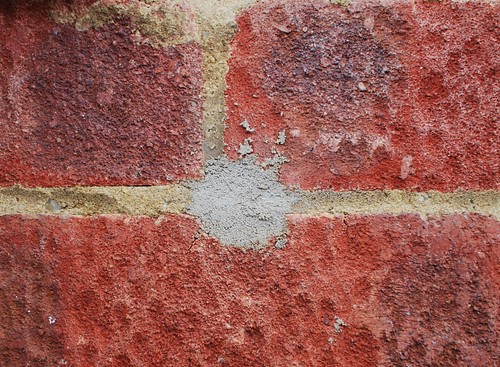


When looking at house to buy how can you tell if there is insulation in the cavity wall.
It can be hard enough to tell if its solid or cavity, but if its a row of houses built with unfilled cavities how can you tell if its had retro fitted
insulation blown in or now? Having lived in one each on the same street i know first hand the difference is huge but if your buying/renting how can
you tell what you have got?
Daniel
You should see small patched up bits of mortar every few feet - a bit like this, but hopefully better 

Some damp proof courses are injected into the mortar like that. If you see holes like that it depends how high they are. DPC would be low(ish) down normally, no disadvantage with blown insulation not to go higher (and easier on the back!).
Air bricks at ground level will of been sealed up as well - usually by mastic or mortar.
Mine has little black caps about a foot off the floor about a foot apart where it has been injected.
Ask the current owner and ask to see the certificate? 
We had ours done last year and it is very difficult to see the refilled holes in the mortar. The difference as opposed to damp proof is that cavity
insulation holes should be all over the walls; at least, it was for ours (blown fibre insulation)
[Edited on 07.02.2011 by Humbug]
An injected damp course will be low down with the holes i the brick. cavity wall injection holes will be all opvber the walls, every metre of so.
quote:
Originally posted by gingerprince
You should see small patched up bits of mortar every few feet - a bit like this, but hopefully better

quote:
Originally posted by Humbug
Ask the current owner and ask to see the certificate?
We had ours done last year and it is very difficult to see the refilled holes in the mortar. The difference as opposed to damp proof is that cavity insulation holes should be all over the walls; at least, it was for ours (blown fibre insulation)
We got a certificate when i bought my house, and can back it up, as when we had new windows fitted, the furry stuff was blowing around in the void
Steve
quote:
Originally posted by Mr G
Air bricks at ground level will of been sealed up as well - usually by mastic or mortar.
 If they have, RUN AWAY! No air circulating under the floors, means rot will follow.
If they have, RUN AWAY! No air circulating under the floors, means rot will follow. quote:
Originally posted by Mr G
Air bricks at ground level will of been sealed up as well - usually by mastic or mortar.
If newish house you wont be able to tell by looking at wall as it should have been installed whilst wall was being built.
In old wall you should be able to see the holes - i doubt a builder could match new mortar with very old, unless of course the whole wall has been
re-pointed since.
Certificate will be best bet, otherwise try and get owner to pay for a wall tie survey. I bet the surveyor will soon kick up a fuss if they are filled
with insulation.
I always thought solid 9" walls were dead easy to spot. Isnt there normally a course of bricks end on every few courses?
quote:
Originally posted by Confused but excited.
quote:
Originally posted by Mr G
Air bricks at ground level will of been sealed up as well - usually by mastic or mortar.
If they have, RUN AWAY! No air circulating under the floors, means rot will follow.
The air bricks should hav ebeen re-placed with platic ones that go all the way through the wall to duct air through the insulation to under the floor. It also stops the insulation falling out under the floor.
quote:Im new to this, but i think its fairly safe to say that if a wall is nine inches (or 11 by the time its plastered one side and rendered the other as most ive been looking at are) but what if you have 1930's house, rendered, with bricks that arnt to modern standard size, and a wall thickness that could be enough to have a cavity.
Originally posted by DarrenWI always thought solid 9" walls were dead easy to spot. Isnt there normally a course of bricks end on every few courses?
1. Certificate
2. Look for the holes patched
3. Open the electric cupboard outside see if you can see any when looking on.
4. Look down into the cavity from the loft if you can.
5 If the house has a solid fuel fire or decrative effect fire you should have a core vent fitted to the outer wall.
other things to look out for is if the walls are brick tied or random stone (natural) or if the house is of a timber frame structure all of these i have seen insualted and will give you problems down the line.
quote:
Originally posted by Confused but excited.
quote:
Originally posted by Mr G
Air bricks at ground level will of been sealed up as well - usually by mastic or mortar.
If they have, RUN AWAY! No air circulating under the floors, means rot will follow.
The air bricks should hav ebeen re-placed with platic ones that go all the way through the wall to duct air through the insulation to under the floor. It also stops the insulation falling out under the floor.
Mr. G, I stand corrected and apologise unreservedly.
On the subject of solid walls. I used to have an old Victorian semi with solid walls. Always warm as toast and never had any penetrating damp. Did
have a full basement and I put in a DPC by injection.